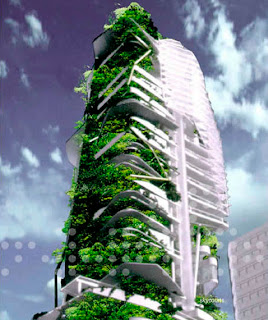
“We shape our buildings; thereafter shape us!” (Winston Churchill)
The impact buildings have on us is evident, for instance high-rise tower blocks were first built in the UK after the Second World War. Initially, they were welcomed as a good option for low cost housing in the UK. However over time the buildings themselves deteriorated, they grew a reputation for being undesirable symbols of urban decay and alienation. Design flaws such as poor ventilation leading to condensation and mould, inappropriate use of materials, i.e. asbestos, lack of community facilities and poor design making cleaning and maintenance difficult, contributed to creating unpleasant and unsafe living environments. This consequently created a breeding ground for drugs, violence, crime and lack of prospects for its inhabitants. As Adolf Behne points out "you can kill a man with a building just as easily as with an axe."
In comparison Dr Ken Yeung considered the occupants and surrounding eco systems when he designed the EDITT tower in Singapore. Many Singaporeans live in high-rise housing or work in skyscrapers to save space for it’s ever growing population.
The EDITT tower is a 26 -storey building that accommodates for humans, plants and birds, in order to improve a degraded eco system in a busy inner city spot. The key biological aspects is the creation of planted areas vertically streamlining the building, whilst the lower six floors are landscaped ramps filled with cafes and shops, integrating the surrounding street life.

The building is designed with a ‘loose fit’ this includes removable partitions and floors in order for future generations to adjust the building when required. Singaporeans rely a lot on its neighbour Malaysia for water supplies, the EDITT building is designed to collect rainwater providing 55% water self sufficiency. When Dr Yeung designed the building he wasn’t just concerned with the environmental solutions but he also made it pleasant for the occupants who live there. Comfort levels were ensured by including elements designed to direct wind for ventilation and ceiling fans with water misters to humidify the air (Faud-Luke, 2005, p239).
As seen with environmental determinism, the designed environments can impact and influence people’s thoughts and behaviours. Designers can learn from past mistake and move forward to design for all species and eco systems, as seen in the design of the EDITT tower. Taking the future into consideration and making sure that past mistakes are not repeated will create a brighter and better future for all of us.
‘The answer will likely depend on the willingness of architects and designers to reach beyond the design community and its traditional audience —to humbly venture into the communities in which they live, listen to the needs of their neighbours, and offer their services.’ (Stohr, 2006, p53)
Bibliography
Faud-Luke, A. (2005) The Eco-Design Handbook, London: Thames & Hudson Ltd
Fletcher, A. (2001) The Art of Looking Sideways, London: Phaidon Press Ltd
Stohr, K. (2006) 100 years of humanitarian design, London: Thames and Hudson
http://en.wikipedia.org/wiki/Architectural_determinism
http://www.sustainingtowers.org/SOA-hist-decline.htm
No comments:
Post a Comment
Note: only a member of this blog may post a comment.